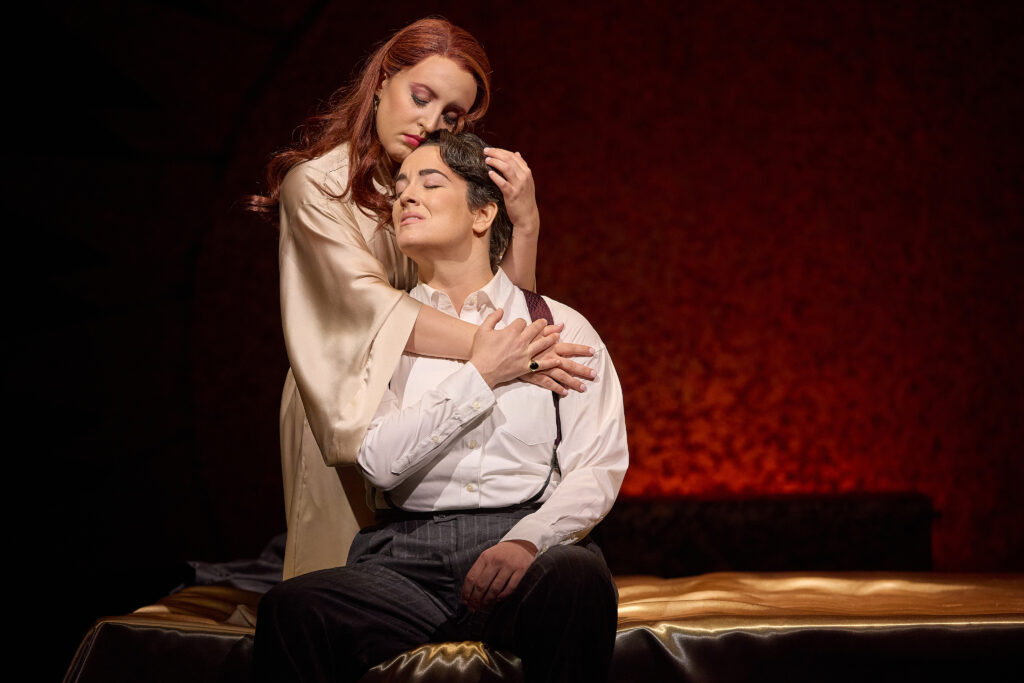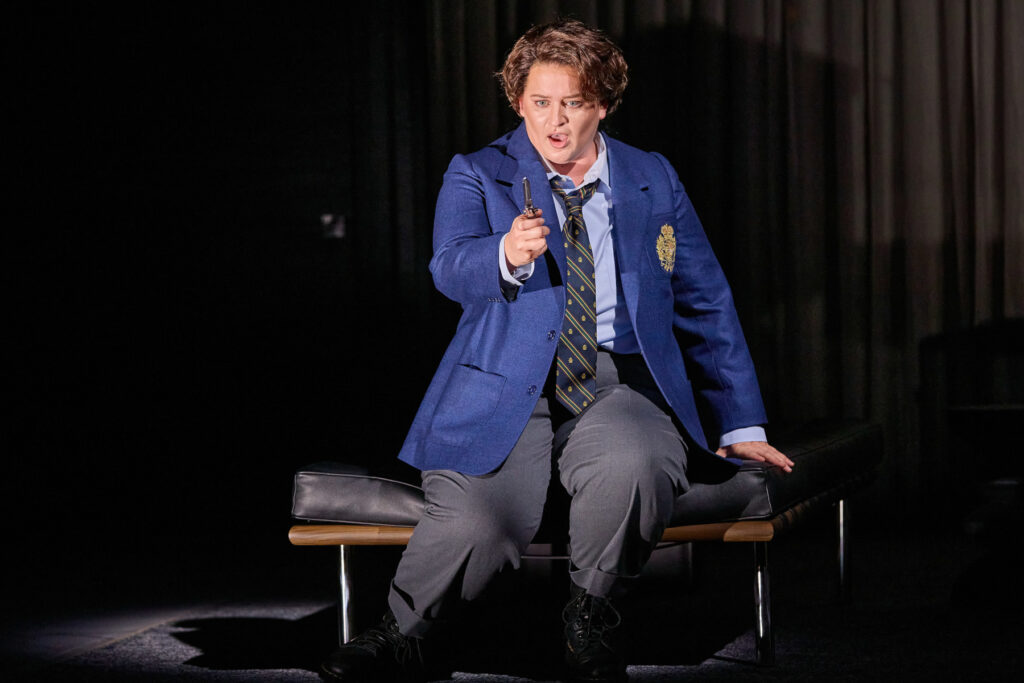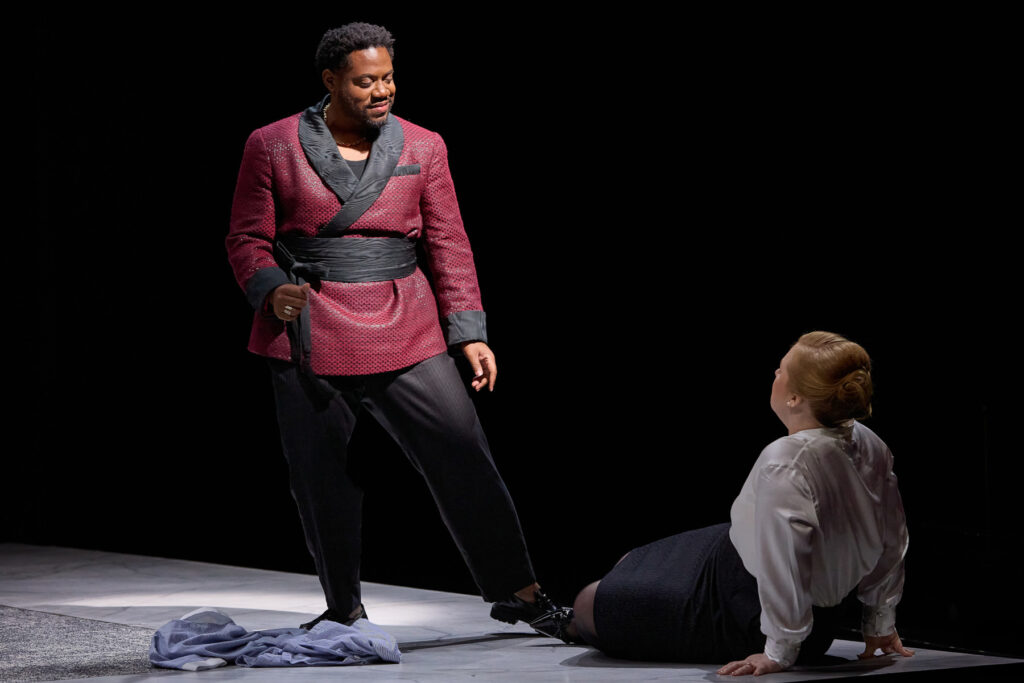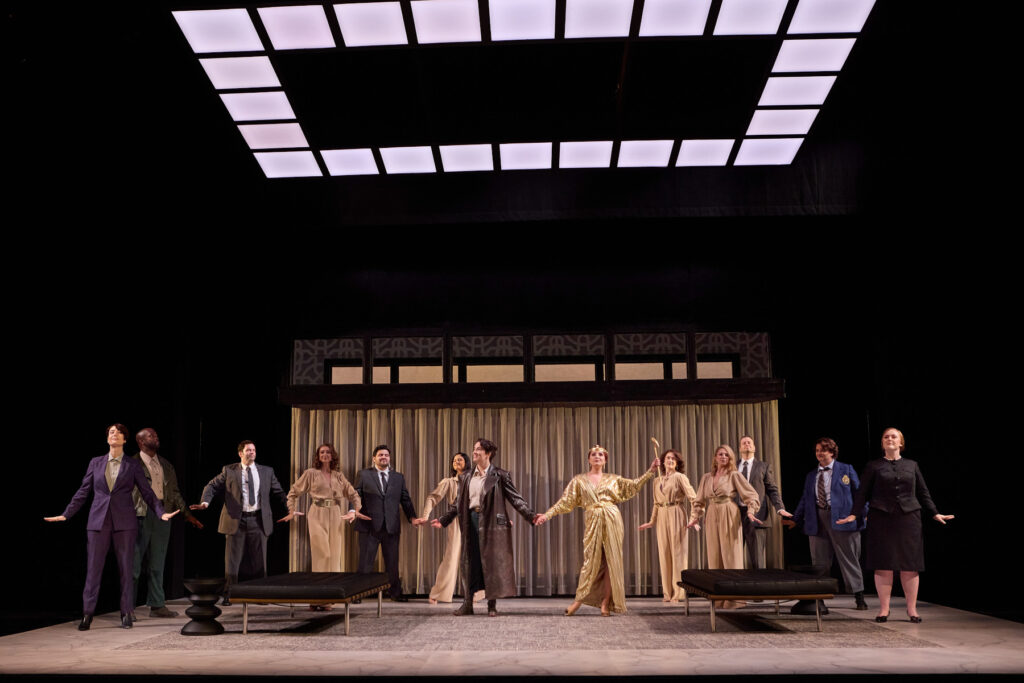A musically resplendent presentation of Georg Frideric Handel’s Julius Caesar covered Opera Theatre of Saint Louis in glory.
Guilio Cesare in Egitto is number one on Handel’s operatic hit parade for good reason. It contains some of his most urgently compelling and meltingly alluring vocal writing, the iconic characters and their journeys are well known, and the dramatic situations crackle with intrigue.
Based on a libretto Nicola Francesco Haym adapted from material by Giacomo Francesco Bussani, it was sung here in an English translation by Brian Trowell with revisions by James Robinson. It is one of the company’s signature intiatives that since its beginnings, OTSL has performed all its productions in English. Even purists are hard pressed to not be wholly engaged by this popular longstanding local practice. The nonpareil cast delivered that text with utmost clarity and vivid theatrical color. And what a cast it was!
I have experienced this piece any number of times in my long opera-going life, but I cannot recall any Cleopatra more completely persuasive in performance than soprano Emily Pogorelc. She has it all: a sizable lyric instrument of spun gold, that effortlessly embraced and conquered the daunting demands of this Everest of a role. From meticulously executed coloratura, to unerring accuracy leaping between registers, to achingly shaped arching melodies, to astonishingly fresh vocal effects, Ms. Pogorelc is the whole star package.

This includes being possessed of the perfect physique du rôle, a captivating beauty that serves Cleopatra magnificently as gamin, vamp, lover, or regal queen. On occasion I have seen major international sopranos be defeated by the sweeping demands of this difficult writing, but none of it held any terror for the extraordinary, nay, wondrous gifts of Emily Pogorelc. Watch her star rise and rise and rise.
Second among equals was the spectacularly assured mezzo-soprano Sarah Mesko, who totally encompassed the challenges of the title role. I tend to prefer a countertenor in this assignment and have also heard a baritone or two in my time. But Ms. Mesko made a convincing case for this trouser role take, with her eloquent, slightly dusky singing, that was deployed with compelling conviction.
Her Caesar cut a good figure with a believably swaggering masculine gait, an unaffected hero who paired charismatically with his Cleopatra. This fine artist was equally effective whether in heartfelt romantic banter, or fiery triphammer melismatic singing during which she sang the spots off the page. Ms. Mesko also notably pulled off the Marilyn Horne party trick of dropping from a searing high note to an amazingly potent chesty low note with no apparent effort. Hail, Caesar!
Meridian Prall’s rich, robust mezzo-soprano was a gorgeous fit for the role of the hapless Cornelia. The character has a number of well-known laments that might suffer from a sameness from a lesser artist. But Ms. Prall has discovered incredible nuance in each of them, and communicated richly detailed, and deeply affecting interpretations. Later, when she decides to become an avenging angel, she also proved capable of searing passion and fire.

As Cornelia’s son, Sextus, mezzo-soprano Megan Moore triumphed as a hot headed young man who was capable of spitting out unerring spot-on cascades of mellifluous phrases, and then prove equally successful at scaling back her striking, pulsating delivery to embody meltingly beautiful heartbreak and loss. The wonderfully wedded introspective duet between Cornelia and Sextus has rarely been heard to better effect.
As the malevolent Ptolemy, countertenor Key’mon W. Murrah adopted a take-no-prisoners approach that earned him enthusiastic appreciation in spite of his comparatively shorter total stage time. Mr. Murrah’s is the most distinctive, incisive, fearless, highest flying countertenor instrument I have ever heard, and thanks to a faultless technique, he was able to present vocal fireworks with unparalleled panache. If you can imagine a highly accomplished castrato with cast iron balls, you’ll get the idea of his potent impression.
Bass-baritone Cory McGee proved to be an ideal Achillas, his searing delivery chillingly driving the action, and driving the objects of his scorn to distraction. His powerful, assured singing is complemented by a lanky, darkly handsome stage presence that not only takes the stage but almost completely fills it. This was a goose-bump inducing role traversal.
Illness sidelined two of the minor cast members, but Gerdine Young Artists saved the night. Justin Ramm-Damon sang Curio with a poised and characterful bass-baritone, replacing John Goddard Mburu. And the delightful Michelle Mariposa put her yummy, plummy mezzo-soprano to fine use as Nirena, ably filling in for Madeleine Lyon.
In the pit, Daniela Candillari led a propulsive, shimmering reading, commanding her forces with idiomatic acumen, and performing with real theatrical flair at the harpsichord to boot. The members of the Saint Louis Symphony responded with a fruitful and impressive partnership with the world class singers. While the ensemble work was seamless, there are two instrumentalists who must be singled out: Roger Kaza thrilled us with his memorable horn solo, and Celeste Golden Andrews delighted us with her playful solo violin passages. It is to be commended that while the most famous da capo arias were presented in their entirety, judicious pruning of others made for a much tauter and enjoyable experience.

I have to confess Allen Moyer’s modern production set design left me scratching my head over its seeming deliberate disconnect with the wholly incandescent excellence and authenticity of the musical achievement. The setting seems to be an office waiting room (meeting room?) in a high rise, with upstage windows looking onto a hallway. Two doors flank the expanse of windows. The only set pieces are two rectangular, tufted black leather and chrome settees. The windows can be fronted on occasion by pulling a sheer white curtain across. This could be any corporate space from say, the 1970’s to the present day.
Director Elkhanah Pulitzer has staged a rather schizophrenic affair, that can be wholly honest and affecting sometimes (as in virtually all of the duet interactions), and puzzlingly off the wall the next (such as the parody of a Charlies Angels pose at a tense moment). For example, it just wasn’t credible that the text is singing of seeing things “in the moment” that just plain weren’t there on the stage.
There were too many unintentional laughs owing to staging miscalculations. The horrifying moment of presenting Pompey’s severed head in front of the swooning widow, Cornelia should not elicit the titters it did. Some intentional laughs were similarly inappropriate. Four mafioso-like thugs who were menacing supers for the whole evening, suddenly break into a goofy Boogaloo in the finale. Huh?
There was also intermittent, incomprehensible semaphoring, gesturing, and hand movements the like of which I hadn’t seen since Peter Sellar’s Theodora. I didn’t get the memo as to what it must mean, and it came off then, and now, like Captions for the Clinically Bewildered.

Constance Hoffman has contributed an eclectic and assured costume design, provided you accept the fact that Cleopatra is presented as Kitten With a Whip, entering as a disco queen, in a blinding gold sequined pants suit. Others are far more conservatively attired, and aside from an unflattering, ill-fitting prep school blazer and high water pants length for Sextus, the dress is flattering and character specific.
There are blue and white uniformed cleaning ladies supers hovering in the hallway mostly going about their business, but after Ptolemy was knifed and killed behind the sheers, did one of them have to comically kick the corpse? In another oddity, when Cornelia is arrested, instead of being imprisoned, she is forced to join the ranks of the cleaning ladies, and she reappears in uniform. Happily, she gets to change back to her handsome back dress for the finale.
Lighting designer Eric Southern did his usual well-considered work here, although some well-executed effects that were chosen were curiously out of sync with the mood of the moment. The entire creative team did have one major trick up its collective sleeve. As part of her reimaging this work, Ms. Pulitzer decided that this modern Cleopatra would have four beautiful female back-up dancers.
Just as I was getting a bit weary of the sameness of Mr. Moyer’s boxy black and white playing space, wondering “really, where ARE we?,” lo and behold, the back wall of windows ascended to the flies, revealing a colorful stage set worthy of a Las Vegas spectacular, with Cleo performing her big set piece backed by four showgirls with ostrich plume fans. Think: “All I Care About is Love” from Chicago.
And then I knew. *Doink.* We were in (wait for it): Caesar’s Palace!
My first ever Giulio Cesare experience was at Frankfurt Opera, and in one of its typical Konzept productions, its scattershot design was inspired by the goofy Belgian animated comic film, Asterix and Cleopatra. So, this night in Saint Louis, I felt I had come full circle. Try as it might, this well-intended, admittedly often persuasive and inventive staging could not for a moment distract from the overwhelming success of the unparallelled radiant musical achievement.
Opera Theatre of Saint Louis is a venerated national treasure that will celebrate a half century in operation next June with its Fiftieth Anniversary Season. I urge you to be there for the rejoicing. You will not only experience some of the finest operatic performances on any stage but will also enjoy the welcoming environment and casual elegance of the OTSL experience. I hope to see you there!
James Sohre
Julius Caesar
Music by George Frideric Handel
Libretto by Nicola Francesco Haym adapted from
Guilio Cesare in Egitto by Giacomo Francesco Bussani
English translation by Brian Trowell with revisions by James Robinson
Julius Caesar: Sarah Mesko; Cornelia: Meridian Prall; Sextus: Megan Moore; Achillas: Cory McGee; Cleopatra: Emily Pogorelc; Nirena: Michelle Mariposa; Ptolemy: Key’mon W. Murrah; Curio: Justin Ramm-Damon; Conductor: Daniella Candillari; Director: Elkhanah Pulitzer; Set Design: Allen Moyer; Costume Design: Constance Hoffman; Lighting Design: Eric Southern; Choreographer: Seán Curran; Wig and Make-up Design: Krystal Balleza and Will Vicari; Chorus Master: Andrew Whitfield
Top Image: Emily Pogorelc as Cleopatra.
All photos © Eric Woolsey.